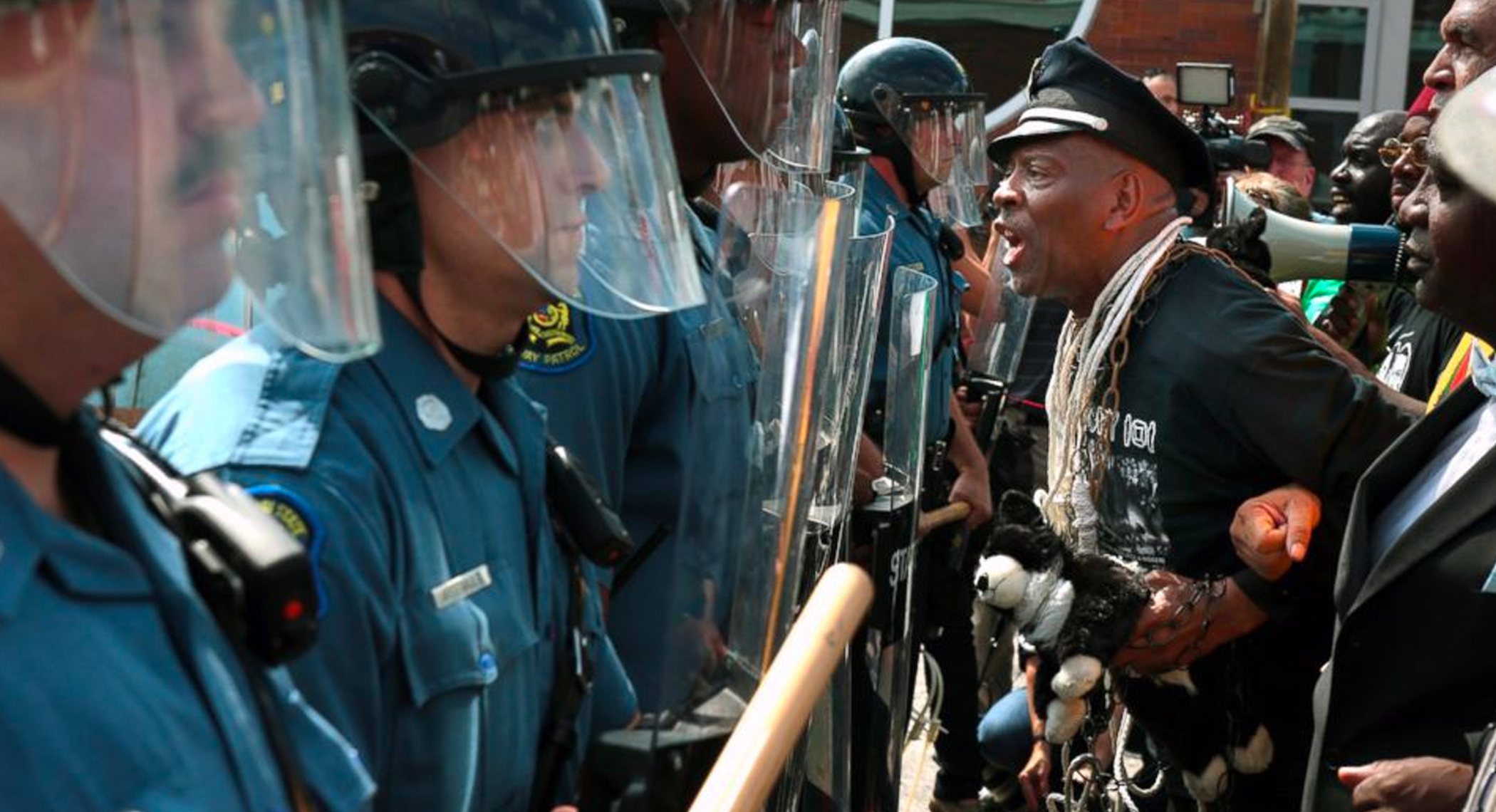Thoughts from the Editor-in-Chief
- Substantial's been telling stories since early 2012. Here's one from the archives.

Pt. 1 – “The Discussion”
Someone asked me why I haven’t joined the discussion as it relates to the civil injustice that is going on in our country right now, the disregard for black lives, and disrespect of our voices. I sighed, and at that moment thought about my response, calculating just how in-depth my reply would or should be. Looking back on the tragic events of 2014 made me ask myself, “Is this person asking me this question because as a black man I should be outraged, as a former full-time police officer I should be defensive or as a believer I should be mortified that we day in and day out deify Exodus 20:13. So at that moment I simply replied, “What discussion?”
The perplexed look on his face meant I owed a further explanation as to why I wasn’t informed about these serious issues. I sighed yet again finding myself in my thoughts. A discussion is defined as an act or instance of discussing; consideration or examination by argument, comment, etc., especially to explore solutions; an informal debate. A discussion means listening as much as we talk, a discussion (pause to come back to the moment), I replied: “Oh I know exactly what’s going on in the world.” Knowing that response would again be followed by another question pulling me further into a conversation that I’m honestly not sure I’m ready to have. The question; so they’re wrong right?
I have to lay this out for you; at this moment I began to have a parallel conversation in my mind as I carry out the conversation in real-time. A conversation that eventually will bring me to a crossroads. A crossroad labeled with a sign that points in one direction yet has two destinations. I sigh, as I search through a file cabinet of my thoughts to come across a black folder marked “APPROPRIATE”. The very first thing in this folder was an image. In this image was a faceless black man who lay lifeless in a casket. The photo was of Emmett Till, a young teenage boy who was tortured and killed after supposedly flirting with a white woman in Mississippi in 1955. The very boy whose murder and open casket funeral galvanized the emerging Civil Rights Movement.
Also in this folder was a newspaper clipping that read: $50 REWARD – Ran away from the subscriber on the 11th of this month, residing near Randallstown, Baltimore County, a N E G R O M A N named MOSES, about 35 or 36 years old and about 5 feet 8 inches in height, full-chested, very polite and talkative when spoken to, dark brown complexion and walks very lame in one leg and uses a cane and a thick-soled boot. I will give $50 if lodged in jail or put where I can get him. DR. JAMES MAGRAW, Randallstown, Baltimore county.
Real-time: I say to my friend, “They” already knowing the answer, yet I still wait for the response of “Man! The police- and more importantly, white officers-are tripping killing all these unarmed black people.”
I sigh, finding myself now sitting at an old wood table. On this table was an even older worn down book that was barely visible by the warm low glow of an oil lamp. The title was “The Slave Narrative”. The first page was the most powerful in that contained a very strong message. “If they find this book they will beat you. Even worse, if they find that you can read this book they may kill you.” See, in most southern states, slaves often suffered severe punishment for the crime of literacy. Most slave owners believed that teaching such skills was useless, if not dangerous. They assumed that slaves had no use for reading in their daily lives and that literacy would make them more difficult to control, and more likely to run away.
Real-time: I say, “Man we have to look at each one of these incidents with open eyes. We have to first assess the Who, Why, When, and where’s. Understand that no one deserves to be killed. Think about how these situations could have been avoided. And think about what sparked such rage for or by authorities that would warrant the death of any man”.
I now find myself out on a city street. Beside me, in front of me, and behind me are brothers and sisters screaming to the top of their lungs “We Shall Overcome”. At that same moment are flashes of those same brothers and sisters being bitten by K9s, knocked down by high-pressure fire hoses, beaten and drug away by their feet.
Real-time: I find myself slipping further and further into agreement as I listen to him describe to me in detail the various incidents that have taken place. Have we truly found ourselves facing the very same discrimination and hatred of our dark past?
I sigh deeply, finding myself in Washington D.C., standing with 250,000 people listening to what will become one of the most famous speeches in American history. As I listen to the prepared remarks of King in the midst of all the chatter and ambient noises, clearly I hear:
I have a dream that one day this nation will rise up and live out the true meaning of its creed: “We hold these truths to be self-evident: that all men are created equal.” I have a dream that my four children will one day live in a nation where they will not be judged by the color of their skin but by the content of their character.”
The inspiration that was felt at that moment can’t be described in words, let alone summed up. I blink and now my environment has changed. I’m not sure exactly where I am at first, then I see him. I see him standing on his second-floor balcony outside his room at the Lorraine Motel in Memphis.
Real-time: I interrupt his briefing to say, “Let’s take a second to take race out of the picture”. The mystified look on his face meant that I owed a further explanation as to why in all the details, we needed to take a look at anything further. His arms cross, his face scrunches and he prepares for my “opening statements”.
If the police had choked out a white man or killed a white kid would we be having this conversation? Would there be national media coverage, protests, and riots? Hell, what if the police officers themselves were killed? I speak these names: Zemir Begic, Tyler Comstock, Henry C. Taylor, Roza Sakhina, Hans Arellano, Jordan Begley, Andrea Rebello, Kristofer Gagliardi, Edwin O. Roman-Acevedo, Christopher Smith, Justin Winebrenner, Michael Joe Naylor, Jason E. Harwood, Wenjian Liu, and Rafael Ramos. He’s puzzled, I think more or less shocked that the names on the list are those of innocent White, Hispanic, Native-American, Bosnian, and Law Enforcement Officers that have too been victims. Oh, the first name that was mentioned Zemir Begic was beaten to death with a hammer by two black teenagers in St. Louis.
I sigh, thinking now to myself that these moments are happening at the most inappropriate times. I’m running, tired, weak, and out of breath, but I’m still running. In my hand I’m carrying a book, having just a split second to glimpse the title “Chaos or Community”. It’s his book. The very man who tried all the time to interpret the black man to a cynical or uninterested white society. I recall now why I’m running as I at the moment recall what was taken from the reading. The cries of Black Power and the riots are not the causes of white resistance, but the consequences of it. I’m running as if my life depended on it, and when I look back to see just why I’m running I’m confused. I’m tired of running; In fact I’ve given up. I’m tired and out of breath, but no longer running. I’ve been caught. Tied now to a tree, my book burns at my feet, my mouth gagged to mute what I believe would be my one tool that could release me. The mobs of faceless people confront me and in that instance why I was running is even more confusing.
Real-time: I say to my friend, “See it does matter as much. Why is it that their families shouldn’t grieve, be mad, and incite violence? Why is America not having their discussions? Why isn’t the media feeding us their stories and the out¬comes of their violator’s trials?”
I sigh, now back at my file cabinet of thoughts searching as I come across a red folder marked “IMPORTANT”. I open it to look through a series of images. One being a very intentionally shot photo of diversity, another an interracial couple, another a group of African American college graduates in caps and gowns, another a daycare of diverse children being cared for by white staff, another a black doctor caring for an elderly white patient, another the CEO of McDonald’s, another of Oprah, another of President Obama and First Lady Michelle Obama, another of Maya Angelou, another of the cast of “A Different World”, and lastly another of “The Huxtable Family”.
After the photos was a note that had scratched on it, July 2, 1964, August 6, 1965, April 11, 1968, the words Affirmative action, Equal Employment Opportunity, Public Assistance, Affordable Housing, The Initiative on Educational Excellence For African Americans…
Real-time: At this point, I think it’s clear to you what I meant when I said this conversation would bring me to a crossroad labeled with a sign that points in one direction, yet has two destinations. My friend let out his own sigh (the very same sigh that I’ve let out throughout our conversation) which leads me to believe he too is having a parallel conversation in his mind as we carry out this one in real-time.
He says, “So you’re telling me that it’s OK that Michael Brown was killed, that Eric Garner was choked to death. That Rumain Brisbon who was dropping off lunch should have been shot on his front steps. You’re telling me that…..
I sigh, finding myself back against the tree and my mouth gagged. At this point, my book has been burned completely and the flames have gone out. I find myself no longer confused, but afraid. You see, that mob of faceless people were not all white; they looked like me. They were my people, and at that moment, it scared me. Have my people become so emotionally scarred by the files marked APPROPRIATE that those marked IMPORTANT should no longer be read.
Real-time: My friend’s voice has become high pitched. His words sterner and his hands make gestures animating the importance of his opinion. I find that I haven’t really been paying much attention to my friend in his rant of why racism still exists. However, he is making such strong arguments.
I sigh, finding myself in our current place and time; asking myself the question, “Have I been so fed the files marked IMPORTANT that I’ve neglected to see those that are truly appropriate.
TO BE CONTINUED…
Greg Hedgepeth
President and Editor-in-Chief of Substantial Magazine.
“We are substantial and so is our purpose.”



